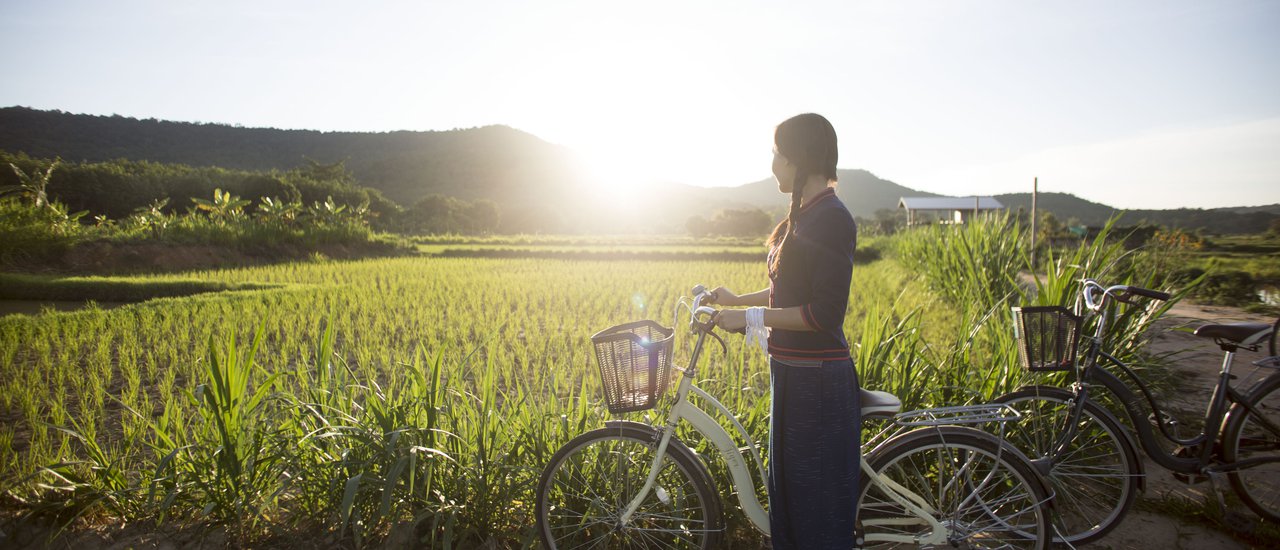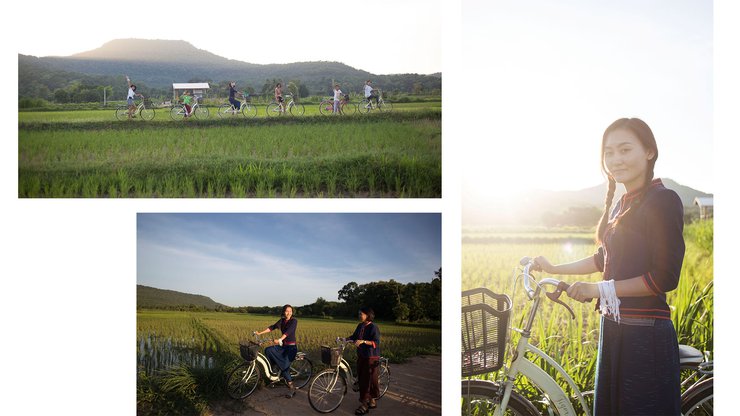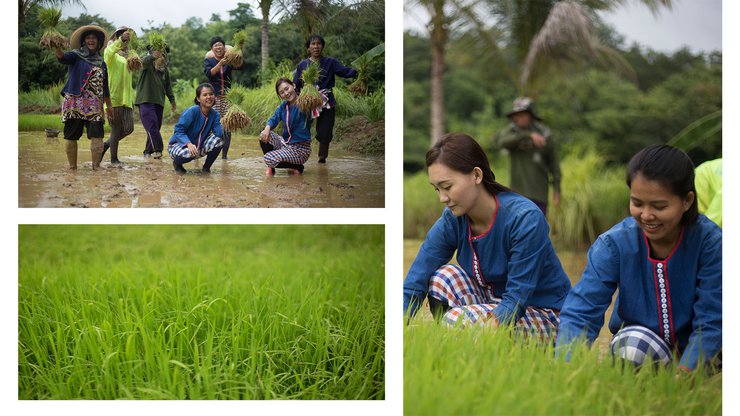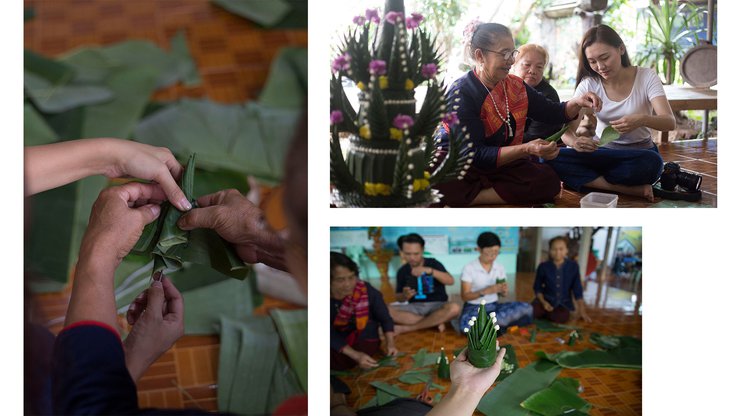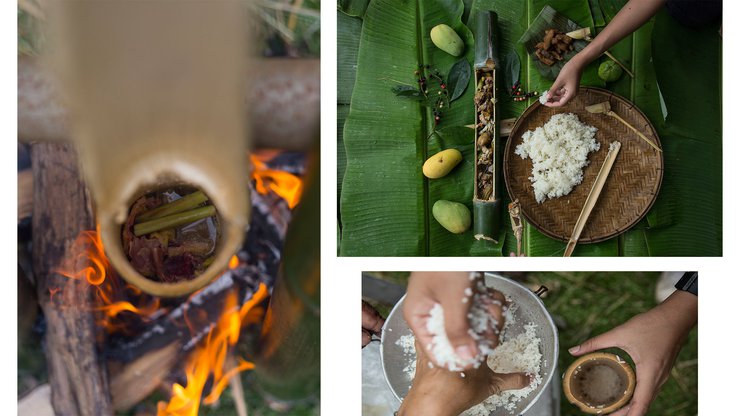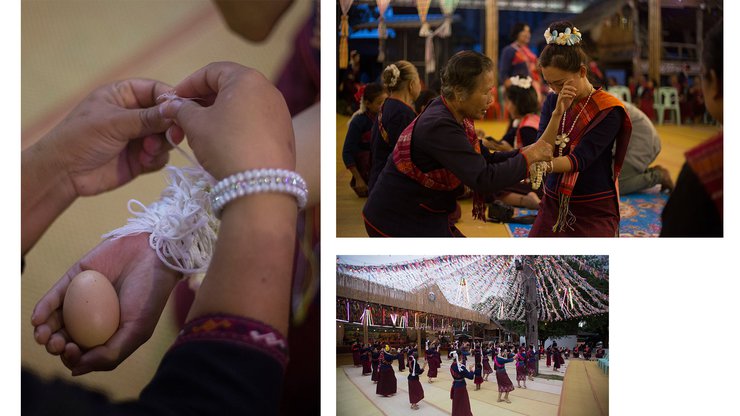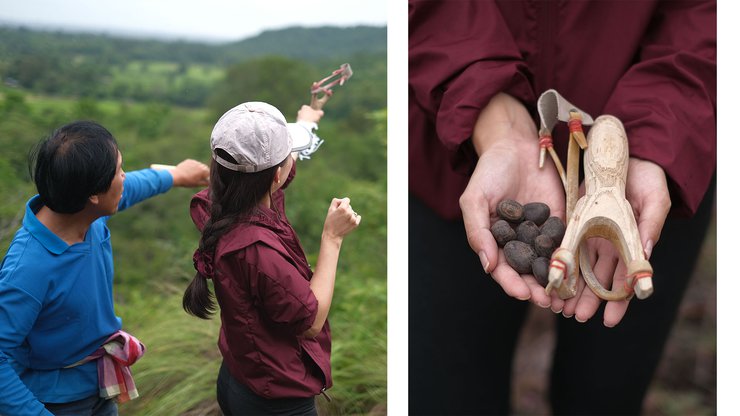My impression of a holiday in Thailand had always been sandy beaches and bustling cities but when I was sent for a blogging project to the Northeast of Thailand, little did I realize I would soon discover a different side to this Kingdom. Here are the top things I cherished during my stay in Ban Phu, Mukdahan in the northeast of Thailand.
Photos by Keerati Saengyai

1. Bicycling along Rice Fields on Sun set.
Ban Phu under Mukdahan province is a quaint little village surrounded by open rice fields and small hills, which turn into a beautiful background during sunset. With less than a thousand residents, houses are lined close to one another separated by flower and kitchen gardens bursting with the fruits of summer. From a single drive by, I saw lemons, pomegranates, mangoes, tamarinds and jack fruit trees in the neighborhood. And one of the best ways to experience the community is by going for a ride on a bicycle. The community centre in the heart of the village has bicycles that you can use for a ride in the evening.
I went cycling with the village children who were more than happy to show me the off beat tracks of Ban Phu that took us directly through the rice fields and into the farms. The golden tone of the sunset, the warm evening breeze and the panoramic views of the rice fields will all make for an amazing cycling experience in this beautiful little community.

2. Becoming a farmer…for a day.
I had been to paddy plantations before but never had I actually worked with the farmers. So when, Phi Daeng (our guide) said we would be planting paddy I didn’t realize he really meant it. I love Thai sticky rice so I was excited about knowing how the food I ate was created in the first place.
Transplanting is a traditional method of rice cultivation used across Southeast Asia. This process requires the crop being seeded in one field, left to grow for a couple of weeks and then picked and replanted in another. Although this is time consuming and requires a huge amount of labour, it gives the seedlings an advantage over any weeds threatening their growth and allows for the careful management of water levels.
The rainy season is the time to plant the paddy when there's abundant water for the seedlings.But due to lack of enough rain the past month, the village had to use irrigation from the creek to put water into the fields. "Simple life! Happy life!" Says Phi Daeng. But the rural life Phi cherishes so much is a difficult one as well. Working in deep mud, backs bent in the scorching heat makes one reflect on the life we take for granted.

3. Attempting to make a Banana Leaf Bai Sri
The Bai Sri is an ornamental tiered centre piece made by banana leaves and flowers central to the Thai Bai Sri blessing ceremony.
I spent an afternoon with Mae (mother) Boon Tuay , the master crafts lady of the village, teaching us to make Bai Sri: the banana leaf tiered ornament used for ceremonies. What started out as "oh this is fun" slowly turned into an exhausting meticulous process of measuring, cutting, folding, twisting and doing it all over again.
I had not realized the amount of patience and precision that goes into making the sacred ornament. Mae kept smiling as I folded, accidentally tore my banana leaf and ended up doing it all over again...several times. I then just decided to watch the master carefully fold and create the elaborate shapes with her fingers with so much grace and poise.
"People buy in city," she says, "here we make." It apparently takes four whole hours to create a three-tiered structure and here I couldn't even finish a tiny part of it during the whole afternoon. After that session, I had a whole new respect for people with skills in the arts especially as meticulous as the art of making a Bai Sri.

4. Cooking Lunch in Bamboo sticks
Thai cuisine is universally loved. But what made my culinary adventure in Ban Phu more exciting was the experience of cooking some of the favorite thai dishes in unconventional utensils…like a bamboo cane.
We found ourselves in the outskirts of Ban Phu marveling the craftsmanship of Ta (Grandpa) Jate Sai as he skillfully started cutting and carving beautiful bamboo products right in front of our eyes. Once a soldier during his youth, Ta Jate Sai spends his day working with bamboo from the forests of Ban Phu. He even made me a set of bamboo spoons and told me to think of him whenever I use them back home.
Soon he finished cutting a hollow bamboo cane with two levels. “Kra bang,” he said pointing at the bamboo which was the name of the bamboo utensil. How do they cook in it? First water is poured in the lower level through the top which trickles through a small hole to the bottom. The water helps steam the rice on the top level. Apparently you need to know exactly how much water goes into the cane, I learned as I saw Ta Jate listen to the changing sounds of water dripping into the bamboo. “Shia Dai,” (enough) he says moving on to putting pre-soaked sticky rice into the top layer. Then sealed with a Pandan leaf, the bamboo is then placed over the open fire. They proceeded in the same process to make the chicken stew as well. In no time we were having sticky rice, chicken & pandan stew and bamboo shoot for lunch served in bamboo canes, with bamboo spoons, over a flat bamboo basket all laid over broad Tani banana leaves. Now this is what I call a pure organic dining experience in the outskirts of Ban Phu.

5. Catapulting seeds on the top on Kok Noi forests
When Phi Daeng said that we’ll be going on a hike in the forest, all I had imagined was a short walk. But what it turned out to be was a masterclass on foraging. Phi kept saying, “Forest is the supermarket of the village,” and as I walked through the trails listening to him I finally understood what he meant by that.
In almost every part of the trail he had something different to show us.“This is good for mother’s milk,” he exclaimed as he took out the hard stem of a plant. “This you can eat with curry,” he pointed to another area. It was a type of betel leaf called Bai Chap Lu famous in Thai cooking. "This is to make cat fish dizzy so you can catch," he said while plucking a round green fruit.
Phi Daeng explained that years ago when people went into the forests with their cattle they would take nothing with them except a small sack of rice. Bamboos would turn into cooking utensils and food? The forest had all kinds of food. You just needed a sense to find it…just like Phi Daeng. He then promised a surprise activity on top of the hill. We were all quite curious about what it was and still had no clue when he took out some catapults from his bag.
“You shoot. Seeds. Plant trees,” he exclaimed. Now this was practicing sustainability and having fun while at it.

6. Being blessed by the Elders of Ban Phu
Something amazing happened to me in Ban Phu. I’m not just talking about the grand parade they community threw for Faii and me, but the beautiful ceremony that proceeded after that. The people of Ban Phu organized a welcome ceremony known as the Bai sri "Soo kwan" ceremony.
Through a dance performance around the Bai Sri (banana leaf decoration offering) the ancestral souls are invited to bless the guests with good spirit and mind after which the Moh Soot (eldest in the village) invite their blessings through prayers and is the first one to tie a holy string around the guest's hand and place an egg that has the good energy of the souls.
I was so honored to be part of such an ancient ceremony. When the elders blessed me with prayers and good wishes, I couldn't help but get overwhelmed with it all and tears started streaming down my face. "Chan Kho Hai Khun Mi Khwam Suk Mak mak na ka" (I wish you much happiness) they said and I shall cherish it forever.

7. Becoming Phu Tai for a day
My hosts at the community were more than happy to dress me up in their traditional wear, a beautiful textile ensemble of a classic Thai Sarong (the bottom wrap) and a buttoned top made from indigo dyed cotton with an intricately designed Sabai wrapped around the shoulder.
The Phu Tai traditional attire is a comfortable and a beautiful ensemble, and although the top seemed quite heavy for a hot day, I didn’t mind it at all. The best part was the hair tied in a high bun adorned with flowers. I couldn’t help but feel like I was really a part of the village, off to a temple to offer some flowers and prayers to Lord Buddha.

8. Making my first organically-dyed fabric
In the village of Ban Phu, many of the locals get around by bike or scooter. Spiky red and green dragon fruit droop from trees outside homes with open ground floors, where women are often seen weaving on enormous rectangular looms. Using cotton threads dyed with birch tree barks, ant poop, they create textiles in an array of patterns.
When they take you on the textile tour, they make sure you have an immersive experience and I sure did. Right from the start I was involved in tying pebbles on a white piece of cloth to create a surprise design. After that we dipped the tied fabric into the dye made from the tree barks we got from Kok Noi forests. While we waited for the dye to soak into the fabric, some of the little girls from the village came by with tall walking bamboo sticks for a game. Trying to walk just a few steps on the bamboo seemed like an impossible task and I kept falling off the sticks, which really amused the little ones casually watching it all happen from their high sticks, balancing perfectly. Soon the dye was done and ready to be soaked in the mud.
“The mud softens the fabric,” said the lady as she splashed the fabric and dunked in the muddy water. After that we rinsed the fabric in ash water which helped the color stay longer. As we carefully removed the stones, the final designs on the now maroon fabric emerged and I couldn't be happier with mine. I was so excited at having created my first organically-dyed fabric from scratch and trust me you’ll be too when you do it yourself.

9. Sunset Tractor Rides
There are several ways to enjoy beautiful sunsets - a stroll along the neighborhood, a bike ride along the trails in the rice fields or you can choose to get on a tractor with the children of the village and enjoy the sunset as they sing several Thai songs in unison. There are very few moments when you travel when you really feel you're part of a place both in body and mind - watching the changing evening sky to the music of the little girls singing their favorite song was one such experience for me personally.

10. Meeting the People of Ban Phu
Ajan Tawan is the village head of Ban Phu. A man of few words but with a constant smile on his face. He doesn't speak English but his daughter, Phi Nik, a Geotechnology graduate describes her father as someone who does everything from his heart.
Ajan Tawan believes that as a community, the people need to think together as one. "One for all & all for one," he says. For a fast-developing country like Thailand I wondered whether communities like Ban Phu, still very rich in their traditions and local Phu Tai identity, would sooner or later be affected by urbanization. "We cannot prevent that. It's natural," she replied also sharing that all the young abled population are now working in the city. "But we can teach our little children the values of our tradition and remind them of who we are."
It was these values that inspired Phi Pik to return to her village to take care of her ailing parents and also help her father with community development. With her education and fluency in English, Phi Nik helps community groups with marketing. Last year alone she helped the group raise more than 600,000 baht selling local organic soaps from Ban Phu. Her father believes that he is proud that the youth are getting an education and is hopeful that they will use their education to help their village become a better community...just like his daughter.

Ban Phu, at a glance, can look like any other northern village in Thailand. You may have seen similar rice fields, or sunsets, or food or landscape. But it is the warmth of the community and the people that makes Ban Phu special. Whether it’s the entire village coming together for a welcome ceremony, the elders blessing you with their prayers or the little girls taking you along for a bike ride along the trails in the vast rice fields, or the evening skyline with orange and pink sunset hues, I realized such moments can be difficult to translate into something other than the experience itself. You have walk in the fields. You have to meet the people. You have taste the richness and listen to the stories of the elders and feel their passion for nature and the sense to protect their resources for posterity. If you want to know what I’m talking about…you have to be…here.
BAN PHU Travel Details
Homestays: 500 Baht per night
Contact Email: [email protected]
Telephone: +66952123612 / +66810474218
LINE: 0894161201
Facebook https://web.facebook.com/weeranuch.weeranuchs
#thevillagestory #villagelife #thailandvillageacademy #banphu #mukdahan
Pema Choden Tenzin
Monday, July 29, 2019 6:23 PM

